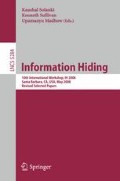Abstract
A common and simple way to create a bootleg video is to simply record a movie from the theater screen. Because the recorded video is not generally of high quality, it is usually easy to visually detect such recordings. However, given the wide variety of video content and film-making styles, automatic detection is less straight-forward. We describe an automatic technique for detecting a video that was recorded from a screen. We show that the internal camera parameters of such video are inconsistent with the expected parameters of an authentic video.
Access this chapter
Tax calculation will be finalised at checkout
Purchases are for personal use only
Preview
Unable to display preview. Download preview PDF.
References
Hartley, R.I.: Estimation of relative camera positions for uncalibrated cameras. In: European Conference on Computer Vision, pp. 579–587 (1992)
Hartley, R.I.: In defense of the eight-point algorithm. IEEE Transactions on Pattern Analysis and Machine Intelligence 19(6), 580–593 (1997)
Hartley, R.I., Zisserman, A.: Multiple View Geometry in Computer Vision, 2nd edn. Cambridge University Press, Cambridge (2004)
Huang, T.S., Faugeras, O.D.: Some properties of the E matrix in two-view motion estimation. IEEE Transactions on Pattern Analysis and Machine Intelligence 11(12), 1310–1312 (1989)
Johnson, M.K., Farid, H.: Metric measurements on a plane from a single image. Technical Report TR2006-579, Department of Computer Science, Dartmouth College (2006)
Longuet-Higgins, H.C.: A computer algorithm for reconstructing a scene from two projections. Nature (10), 133–135 (1981)
Lucas, B.D., Kanade, T.: An iterative image registration technique with an application to stereo vision. In: Proceedings of the 7th International Joint Conference on Artificial Intelligence, pp. 674–679 (1981)
Mendonça, P.R.S., Cipolla, R.: A simple technique for self-calibration. In: Computer Vision and Pattern Recognition (1999)
Popescu, A.C., Farid, H.: Exposing digital forgeries in color filter array interpolated images. IEEE Transactions on Signal Processing 53(10), 3948–3959 (2005)
Shi, J., Tomasi, C.: Good features to track. In: IEEE Conference on Computer Vision and Pattern Recognition, pp. 593–600 (1994)
Tomasi, C., Kanade, T.: Detection and tracking of point features. Technical Report CMU-CS-91-132, Carnegie Mellon University (1991)
Wang, W., Farid, H.: Exposing digital forgeries in video by detecting double MPEG compression. In: ACM Multimedia and Security Workshop (2006)
Wang, W., Farid, H.: Exposing digital forgeries in interlaced and de-interlaced video. IEEE Transactions on Information Forensics and Security 3(2), 438–449 (2007)
Wang, W., Farid, H.: Exposing digital forgeries in video by detecting duplication. In: ACM Multimedia and Security Workshop (2007)
Zhang, Z.: A flexible new technique for camera calibration. IEEE Transactions on Pattern Analysis and Machine Intelligence 22(11), 1330–1334 (2000)
Author information
Authors and Affiliations
Editor information
Editors and Affiliations
Rights and permissions
Copyright information
© 2008 Springer-Verlag Berlin Heidelberg
About this paper
Cite this paper
Wang, W., Farid, H. (2008). Detecting Re-projected Video. In: Solanki, K., Sullivan, K., Madhow, U. (eds) Information Hiding. IH 2008. Lecture Notes in Computer Science, vol 5284. Springer, Berlin, Heidelberg. https://doi.org/10.1007/978-3-540-88961-8_6
Download citation
DOI: https://doi.org/10.1007/978-3-540-88961-8_6
Publisher Name: Springer, Berlin, Heidelberg
Print ISBN: 978-3-540-88960-1
Online ISBN: 978-3-540-88961-8
eBook Packages: Computer ScienceComputer Science (R0)

